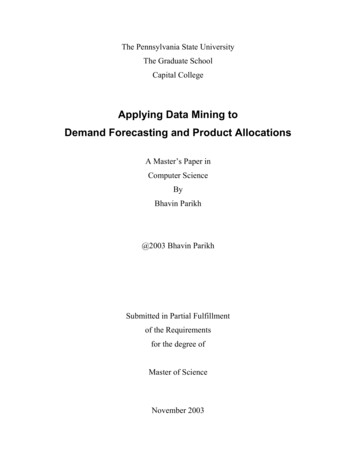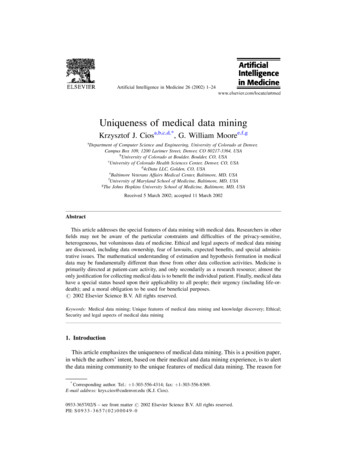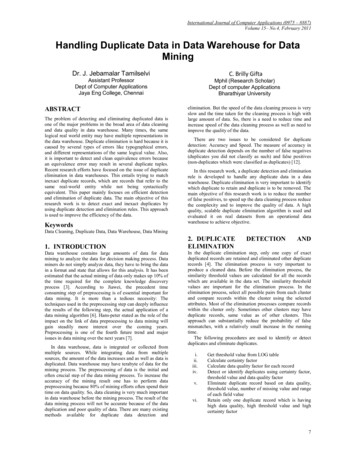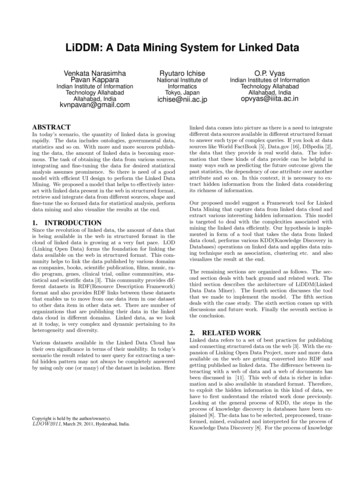
Transcription
The Pennsylvania State UniversityThe Graduate SchoolCapital CollegeApplying Data Mining toDemand Forecasting and Product AllocationsA Master’s Paper inComputer ScienceByBhavin Parikh@2003 Bhavin ParikhSubmitted in Partial Fulfillmentof the Requirementsfor the degree ofMaster of ScienceNovember 2003
AcknowledgmentI would like to take this opportunity to thank my project advisor, Dr. Q. Ding. Herknowledge and experience helped me to finish this project successfully. Her guidanceand encouragement throughout this project are deeply appreciated. I am grateful to thecommittee members: Dr. T. Bui, Dr. P. Naumov, and Dr. L. Null for reviewing thispaper.I would like to gratefully acknowledge Spectra Marketing for their kindpermission to use their data and information for this project. My hearty thanks to Dr. C.Getchell, SVP of Research Group, for his guidance and comments. I would like to thankDr. C. Getchell, Richard Mahon and Roger Meimban (members of Research Group) forproviding data and information for this project. I would like to thank Leo Tubay, Directorof Development Group, for helping me to setup SAS Exceed Software. I also would liketo thank Chandu Patel, Oracle DBA in Development Group, for helping me duringOracle 9i installation and to setup sqlnet.ora and tnsnames.ora in SAS UNIX Servers. Iwould like to extend my hearty thanks to Dennis Klos, SVP of Development Group, forproviding me hardware and software resources as well as encouragement for this project.Finally I would like to thank Hemali, my wife, for providing me constantencouragement during the project.i
AbstractThis paper presents data mining based solution for demand forecasting andproduct allocations applications. Accurate demand forecasting remains difficult andchallenging in today’s competitive and dynamic business environment, but even a littleimprovement in demand prediction may result in significant saving for retailers andmanufactures. This project aims to improve the accuracy of demand forecasting byimplementing multi-relational data mining process on store, product and shopper’s datasets. This paper proposes two data mining models, Pure Classification model and HybridClustering Classification model. Pure Classification model uses k-Nearest NeighborClassification technique, and Hybrid Clustering Classification first uses k-Mean ModeClustering to define clusters and then k-Nearest Neighbor classification to find k mostsimilar objects. Hybrid Clustering Classification model introduces a new concept ofcombining existing data mining techniques on the multi-relation data sets. Experimentalresults show that Hybrid Clustering Classification is promising in practical situations.The data mining application is implemented in Java 2 version 1.4.1. The user interface iscreated with the help of Java Swing classes. Oracle 9i Release 9.2.0.1.0 is used as theapplication database system. The application is designed to be extendable at every levelof the system.ii
Table of ContentsAcknowledgment . iAbstract . iiTable of Contents. iiiList of Figures . vList of Tables . vi1Introduction. 12Data Set Overview and Data Preparation . 32.1Data Set Overview . 32.2Data Preparation. 42.2.1Data Loading and Integration . 52.2.2Domain Analysis. 52.2.3Data Cleaning and Data Reduction. 72.2.4Data Transformation . 82.33456Evaluation Strategy. 9Pure Classification (PC) Model . 113.1Distance Measures . 113.2Pure Classification Algorithm. 123.3Test Experiments and its Evaluation. 13Hybrid Clustering Classification (HCC) Model . 154.1Hybrid Clustering Classification Algorithm. 154.2Test Experiments and Their Evaluation. 174.3Comparison of HCC model and Spectra’s GAP model. 204.4Comparison of PC and HCC models and discussions . 20Implementation Review . 225.1Application Architecture Overview. 225.2Input Interface. 255.3Output Presentation. 28Conclusion . 30iii
Appendix A – Table Descriptions. 31Appendix B – List of attributes. 33References. 35iv
List of FiguresFigure 1: Data Mining Process Overview. 2Figure 2: Application Core Schema Diagram. 3Figure 3: Integration from External Data Sources. 5Figure 4: Store Populations over Density . 6Figure 5: k-NN Evaluation for Different k . 14Figure 6: Experiments with the Number of Clusters . 17Figure 7: Experiments with the Number of Included Clusters . 18Figure 8: Example of Test Samples Located on Border or Between Clusters. 19Figure 9: Experiments with the Number of Nearest Neighbors . 19Figure 10: Application Layers Diagram . 23Figure 11: IClassifier, IFilter, and IDistance Interfaces . 24Figure 12: User Interface - Setup Tab. 26Figure 13: User Interface - Clustering Tab . 27Figure 14: User Interface – Classification Tab . 28Figure 15: Model Evaluation Presentation . 29v
List of TablesTable 1: List of Store Numerical Attributes . 6Table 2: List of Store Categorical and Boolean Attributes. 7Table 3: k-NN Evaluation Matrix for Different k. 14Table 4: RMSE Comparison between HCC and GAP Models. 20Table 5: Prediction Accuracy Comparison between PC and HCC Models. 21Table 6: HCC Model’s Performance Improvement over PC Model . 21vi
1IntroductionDemand forecasting and product allocations are key business functions forretailers and manufacturers. Demand forecasting helps retailers to identify underachieving stores where the potential sales of a product appear to exceed the actual salesof the product. Product allocations assist manufacturers to allocate products to stores andaccounts. The majority of retailers still conduct demand forecasting and planning usingoutdated, often homegrown systems that lack forecasting algorithms and analytical tools[1]. Product demand in a store can depend upon various store attributes, such as sizerelated factors and information about different departments, and shopper attributers suchas income, age, education etc., and the product attributes such as brand name. Some otherfactors such as competition between stores and population density can also affect actualsales of a product in a store. Extensive information related to stores, products and shopperrelations are being collected for retailer and manufacturer industries. Without using datamining techniques and models, not only is it difficult to design system with betterdemand forecasts but it is also not efficient to handle large data set with many relationsand attributes.The paper introduces a new sophisticated demand forecasting and productallocation application based on various data mining techniques. The business objective isto predict potential sales of products considering various store, product and shopper’sdemographic attributes. This objective drives the entire data mining process. Figure 1.1shows the complete data mining process used to achieve the business objective. The nextstep involves identifying the required external data sources. The Loading and Integrationprocess loads data from the external sources and combines them in one database instance.Then the data preparation steps are performed to ensure the quality of the selected datasets. The proposed data mining models, Pure Classification (PC) and Hybrid ClusteringClassification (HCC), implement different mining techniques on the processed data. Bothmodels support multi-relation data mining with efficient search and indexing techniques,combining with existing data mining techniques. The Hybrid Clustering Classificationmodel introduces a new concept of combining existing data mining techniques on themulti-relation data set. Finally, the Evaluation step analyzes test experiments of each1
model, and then compares both models in terms of accuracy and performance.Experimental results show that the Hybrid Clustering Classification model providesbetter accuracy with significant efficiency improvement over the Pure Classificationmodel.StoresProductsConsumers .External DataSourcesOneIntegratedDatabaseLoading &IntegrationCleaning ReductionTransformationPC ModelEvaluationHCC ModelPreprocessing StepsMining ModelsFigure 1: Data Mining Process OverviewThe concept of combining existing data mining techniques to produce new hybridmethods is relatively new. Dan Steinberg and Scott Cardell [3] introduced two newhybrid models, CART-Logit model and CART-Neural Net model, by combining decisiontree methods with neural network techniques and logistic regression. Their testexperiments on real world examples and artificial data sets show that the hybrid model isalways better than either component alone. Jin Jia and Keiichi Abe [4] proposed a newalgorithm for generating a tree classifier by using instance-based learning and clusteringmethod. The new algorithm utilizes a clustering method as preprocessing and a k-NearestNeighbor classification as a complementary classification applied to each cluster [4].The paper is organized as follows. Section 2, Data Set Overview and DataPreparation, describes data set and preprocessing steps to prepare the data for data miningmodels. Sections 3 and 4 introduce Pure Classification and Hybrid ClusteringClassification models with evaluation, respectively. Section 5 reviews the applicationfrom user and programmer’s perspectives. The paper ends with some conclusions andfuture enhancements, in Section 6.2
2Data Set Overview and Data PreparationData Set Overview provides an understanding of each key relation and itsattributes. Data Preparation discusses all preprocessing steps to prepare the data formining models. This section also studies the evaluation strategies used to evaluate PC andHCC models.2.1Data Set OverviewThe application data set contains the following key information: the stores andtheir facts, products and their attributes, and shoppers and their demographics attributes.Additionally, it also contains actual sales data for products and stores carrying theproducts. Actual weekly sales data for each product and store carrying the product arestored in STORE PRODUCT SALES table. Spectra Marketing provided all necessarydata set for this project. Figure 2 shows all key tables along with the number of records ineach table. Appendix A shows the complete database schema of this application.Database constraints are defined to ensure efficiency during reading data from multipletables.STORES(22,902 Records)FACT DATA(583,026 Records)FACTS(45 Records)DI DATA(2,919,326 Records)PRODUCTS(192 Records)STORE PRODUCT SALES(3,092,529 Records)Figure 2: Application Core Schema DiagramStore data set: The three tables, STORES, FACTS, and FACT DATA, in Figure 2represent the store data set. The store data set contains 22902 distinct stores that arerepresentative samples of all stores in the USA. Each store has 55 different factsincluding the location information for each store. The location attributes basicallyrepresent longitude, latitude, and address information. All the facts but location attributes3
are divided into three data types. Many attributes are listed in the domain analysissection. Numerical attributes: Store size related facts are examples of numerical attributes.Selling area in square foot, the number of full-time employees, and the number offront-end checkouts are the numerical attributes. There are a total of 11 numericalstore attributes in the store data set. Categorical attributes: The set contains 8 categorical attributes. The store’s formatand account information are important categorical attributes. Boolean attributes: The store dataset contains information about the presence ofdepartments and in-store services such as the presence of a bakery and thepresence of prepared food as Boolean attributes. There are a total of 26 Booleanattributes in the store dataset.Product data set: The product data set contains information about 192 different productsof various product categories. The PRODUCTS table represents all 192 unique products.Product brand and product category are the two categorical attributes in the product dataset.Shopper’s demography data set: The shopper demographical attributes, such as age andthe presence of children, represent the customers who shop for the products in stores.Unlike the stores and the products data set, the shopper’s demography data set is relatedboth to stores and to products. The data set contains 9 different demographical attributes,and all of those are numerical attributes. The DI DATA table represents the shopper’sdemography information for each product and the stores carrying the product.2.2Data PreparationAn important portion of any data mining project is to prepare the data for miningmodels. The Data Preparation process starts after identifying the business objective. DataLoading chooses and loads the right data set from external data sources, and DataIntegration combines them into one database instance. Domain Analysis helps tounderstand details about the problem and the data sets, and an understanding of domains4
helps to clean data and reduce dimensions. Data Cleaning and Reduction briefly touchessome basic methods to work with inconsistent and incomplete data. Finally DataTransformation prepares the data for the classifier model.2.2.1 Data Loading and IntegrationWe identified three key data sources - stores, products, and shopper’sdemography of the year 2002 - for this project. All these data files were available invarious formats and from different locations. The products data set, shopper’sdemography, sales data, and most of the stores data were available in different SAS files,and the remaining store’s information was available in Text/Excel files. After identifyingthe correct data set, the data were extracted from the external data sources according totheir formats and loaded into the Oracle 9i instance. SQL*Loader utility was used to readSAS data files and Text/Excel files as shown in Figure 3.StoresSASSQLLoaderOracle 9i ServerProductsSASSQL LoaderShoppersSASText FilesExcel FilesFigure 3: Integration from External Data Sources2.2.2 Domain AnalysisDomain analysis plays a very important role in any data mining project. The mainpurpose of this step in the project was to understand details about the problem and thedata set. The domain analysis started immediately after the business problemidentification, and continued throughout this project. The first step was to work with adomain expert group to identify the relevant data for this project. We studied the externalstore, product, and demography data sources to understand each attribute. Basic statisticalanalysis was performed to compute range, mean, standard deviation, and population5
distribution for each numerical attribute, and population distribution for categorical andBoolean attributes. Figure 4 shows an example of a population distribution diagram thatrepresents a store’s population for each density value. Density represents the populationintensity near a store, where low value represents sparse area and high value representsdense area. Tables 1 and 2 list store numerical attributes and categorical/booleanattributes respectively. Appendix B provides a list of all attributes used in thisapplication.Store Numerical FactPopulation densityTotal householdsStores competitionAll comodity value# of checkouts# of end-aisle for contractFull time employeesSelling area in sq. ft.Average weekly volumeGrocery selling areaGrocery weekly volumePop 722403,87333,006294,972Table 1: List of Store Numerical Attributes35025020015010050Population DensityFigure 4: Store Populations over 54433221100Store Counts300
Store Categorical/Boolean FactStore formatAccount of storeMerchandising typeFirm size of storeType of storePresence of an in-store bakeryPresence of a full service bankPresence of beer and/or wine sectionsPresence of a bulk food sectionPresence of coffee grindersPresence of an in-store service-deliPresence of a fast food franchisePresence of an in-store seafood counterPresence of an in-store floral centerCarries a full line of general merchandisePresence of gasolineSuepermarket emphasizing gourmet products and brandssupermarket appealing to hispanic customersLimited assortment ( 1500 items)Store sells lottery ticketsPresence of an in-store restaurantPresence of an in-store salad barPresence of a seasonal aislePresence of an in-store cosmetic counterPresence of a specialty cheese centerPresence of an in-store service meat/butcherHigh volume cigeratte salesPresence of an in-store video rental departmentStore sells videosIndicating store remodeled since last surveyPresence of prepared food sectionPop CountDistinct 022288,9928,9558,5648,962Table 2: List of Store Categorical and Boolean AttributesThe domain analysis process continued even after the data preparation step.Understanding the importance of different attributes helped us to implement attributeweighting in data mining models. Some attributes may be given more importance byassigning larger weights to them.2.2.3 Data Cleaning and Data ReductionThis step is necessary to ensure the quality of the selected data, and to improve theaccuracy of the mining models. The external data sources are quite clean, but still they7
are not consistent enough to apply directly to the data mining models. One of the earlierissues was that each original data set was in a different format and isolated from eachother, so they did not have the same structure, naming conventions, or consistency amongthem. The following efforts were taken to remove the incomplete and inconsistent data.1. The first issue was to handle inconsistent data types. Some attributes in one externaldata source were VARCHAR2 or STRING, and the same attributes in other externaldata sources were NUMBER. So we converted data types of the attributes to the mostsuitable ones.2. Some important attributes and/or actual values (class label) were missing in store datasets. For example, a couple of stores were removed because they were missing manyfacts. Some store and product records were removed because there were missingimportant relationships.3. Some records were found to be duplicates, and thus they were deleted from thedatabase.4. We identified many outliers in one external data source due to the mistakes ingenerating the data set from other information, and all of them were corrected byregenerating them from original data sources.5. Some attributes that did not have a large enough population or had just one value forall records were deleted from the system.In many cases, we ignored missing and incomplete records. But sometimes it is moreuseful for a data mining model to replace the missing values with the most suitablevalues. The next section discusses the data transformation, which is the last step in datapreprocessing methods.2.2.4 Data TransformationThe purpose of this step is to transform the selected data into appropriate forms toproduce the analytical data model. Jiawei Han and Micheline Kamber [2] suggest varioustransformation methods based on selection of data mining models and input data sets [2].We applied the log transformation first, and then normalized all the numerical attributes8
in the range of [0, 1] using min max normalizations in our experiments. Both techniquesare described briefly as following:Min Max NormalizationThis method transforms the data in the same range of values such as [Min, Max].Otherwise, the attributes with larger ranges will be treated as more important.Normalizing the all-numerical attributes will also help speed up the learning process.Min Max Normalization maps a value v of attribute A to v ' in the range[ new max A , new min A ] by computing [2]:v' v min Amax A min( new max A new min A ) new minAALog TransformationLog transformation helps to correct problems with skewed data and unequal variations.Many attributes of the data set had no upper bound and the largest values in the differentattributes were many times larger than the smallest values of the same attributes. We usethe natural logarithm (base e) for the log transformation method. The following logfunction transforms v to v ' .v ' log e (v)2.3Evaluation StrategyIt is necessary to decide what evaluation strategies are required to analyze the PCand HCC models. Sometimes it is difficult to measure numeric prediction as the errorsare not just present or absent but they come in different sizes [8]. This section describestwo types of evaluation measures that are used in this application to measure the accuracyof the data mining models. The selected evaluation measures are simple and not verycomputation-intensive.Error Measures: The application uses Root Relative Squared Error and RelativeAbsolute Error measures. Root Relative Squared Error (RRSE) is the most suitable error9
measure for this application. This error measure emphasizes the relative error differencesrather than absolute error values. For example, 10% error is equally important whether itis an error of 50 in a prediction of 500 or an error of 0.5 in a prediction of 5. RelativeAbsolute Error simply adds up individual errors without taking into account their signs.Both error measures are defined as follows [8]:Root Relative Squared Error Relative Absolute Error ( p1 a1 ) 2 L ( p n a n ) 2, where(a1 a ) 2 L (a n a ) 2p1 a1 L p n a na1 a L a n a1 na ain i 1,where a1 , L, a n are actual values and p1 ,L, p n are predicted values.Prediction Accuracy: This evaluation method counts the percentage of test samplesfor which the actual and modeled results are within n percentage. The following rangesare used in the evaluation of the mining models. Prediction within 5 percentage difference between actual values and predicted values Prediction within 6 percentage to 10 percentage difference between actual values andpredicted values Prediction within 11 percentage to 25 percentage difference between actual valuesand predicted values Prediction within 26 percentage to 50 percentage difference between actual valuesand predicted values Prediction with more than 50 percentage difference between actual values andpredicted valuesThe Data Preparation section covers all the steps before designing data miningmodels. Without sufficient and efficient data preprocessing techniques, data miningmodels can never find interesting results or patterns. After the data preparation step, thepreprocessed data is now ready to be used by the analytical data mining models. We willintroduce the Pure Classification (PC) model in the next section.10
3Pure Classification (PC) ModelThe Pure Classification (PC) model uses the k-Nearest Neighbor classificationtechnique with weighted distance measure and attribute weighting. The k-NearestNeighbor classification method is an instance-based learning method that reads trainingsamples by joining among multiple relations and stores them in memory, and thenclassifies test samples directly from the training samples instead of learning any rules. kNearest Neighbor classifiers are among the simplest and yet most efficient classificationrules and are widely used in practice [6]. Many research studies have shown that thepredictive accuracy of k-NN algorithms is comparable to that of decision trees, rulelearning systems, and neural network learning algorithms on many practical tasks. Inaddition, it has been shown that the probability of error of Nearest Neighbor classificationis bounded above by twice the optimal Bayes probability of error [5]. The k-NN classifierprovides good predictive accuracy with large sample data at the cost of high computationand storage requirements. This section discusses distance measures that are used in bothdata mining models to find the distance between objects. The k-NN classifier workflowand its evaluation are described in detail later in this section.3.1Distance MeasuresThere are many different ways a distance function can be defined, and it is hard tofind the most suitable one especially when there are attributes other than numerical ones.The PC model (and the HCC model too) does not depend upon any specific distancefunction. In other words, the application can work with any distance function such as theEuclidean or Manhattan distance function. Euclidean distance is the most commonly useddistance function for the k Nearest Neighbor classifier and k Mean Clustering classifier,and thus we decided to use the modified version of Euclidean distance as a defaultdistance measure. The weighted Euclidean distance function d (i, j ) between instances iand j is defined as follows:d (i, j ) n dp 1( p)ij,11
where d (i, j ) is computed based on the attribute data type p:( p) w ( p ) (d i( p) djIf p is a boolean or categorical attribute: d ij( p) w ( p ) if d iIf p is a numerical attribute: d ijd ij( p)3.2( p) 2) .( p) dj( p); otherwise 0.Pure Classification AlgorithmThis section describes the k-Nearest Neighbor technique with the weighteddistance measure. Building the classifier, and classify unknown samples from theclassifier are the two important steps in the following algorithm.Algorithm: k-Nearest Neighbor ModelInputs: integer k - number of nearest neighbors, training set, testing set, attributes withweights, distance functionOutput: predicted values of the test samples, evaluation measuresMethod:1. create a separate instance for each training record with its actual value;2. for each test sample sa. find k nearest neighbors from the training set by computing distance betweeneach instance of the training set and the test sample s;b. compute the average value of the actual values of k nearest neighbors, andassign as predicted value for the test sample s;3. compute evaluation measures from a set of predicted values and actual values of thetest samples;The k-NN classifier
Then the data preparation steps are performed to ensure the quality of the selected data sets. The proposed data mining models, Pure Classification (PC) and Hybrid Clustering Classification (HCC), implement different mining techniques on the processed data. Both models support multi-relation data mining with efficient search and indexing .










